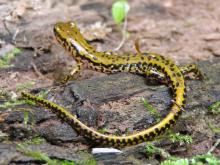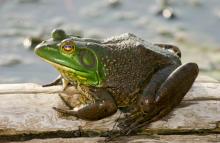Reptiles and Amphibians
Media

Species Types
Scientific Name
Nerodia erythrogaster
Description
The plain-bellied watersnake is a medium-sized, heavy-bodied, dark-colored, semiaquatic snake with a plain yellow belly. It's present in the Bootheel and north along the Mississippi River floodplain, and along our southernmost counties and northward in western Missouri into parts of northwest Missouri.
Media

Species Types
Scientific Name
Nerodia cyclopion
Description
The Mississippi green watersnake is a medium-sized, heavy-bodied, dark-colored semiaquatic snake that was once somewhat common in southeastern Missouri. It probably no longer occurs in our state at all.
Media

Species Types
Scientific Name
Trachemys scripta elegans
Description
The red-eared slider is an attractive aquatic turtle with yellow pinstripes and red ears. It is commonly seen basking on logs or rocks and occurs statewide, except for a few northern counties.
Media

Species Types
Scientific Name
Opheodrys aestivus aestivus
Description
The northern rough greensnake is a long, slender snake common in the Ozarks. It is light green above with a white or yellowish belly. The scales on the back have small ridges that feel rough to the touch. Its beautiful green color helps this mild-mannered insectivore blend in with tree leaves.
Media

Species Types
Scientific Name
Opheodrys vernalis
Description
The smooth greensnake has been declared extirpated from Missouri. If it is ever found again within our borders, it will probably be as small, relict populations in grasslands in the extreme northern counties. It differs from the similar rough greensnake by having smooth scales, a preference for grassland habitats, and a more northern distribution in Missouri.
Media

Species Types
Scientific Name
Eurycea longicauda longicauda (eastern dark-sided salamander) and E. l. melanopleura (dark-sided salamander)
Description
The eastern long-tailed salamander and closely related dark-sided salamander are agile and can escape predators by using their tails for quick jumps. They live in the southern and eastern parts of Missouri.
Media

Species Types
Scientific Name
Graptemys pseudogeographica pseudogeographica
Description
Missouri has two subspecies of false map turtle. The northern false map turtle occurs in the Missouri River in central and northwestern Missouri and the upper Mississippi River. The Mississippi map turtle occurs in the lower Mississippi River, southern Ozark rivers, and southwestern Missouri.
Media

Species Types
Scientific Name
Chrysemys picta bellii
Description
The western painted turtle is a small, brightly colored aquatic turtle. The upper shell is smooth and has a red-orange outer edge. The colorful lower shell has a prominent pattern of brown markings. It is found nearly everywhere in the state except the southeast region.
Media

Species Types
Scientific Name
Lithobates catesbeianus (formerly Rana catesbeiana)
Description
The American bullfrog is Missouri’s largest frog. This common species is easy to hear on warm nights when the males call a deep, sonorous “jug-a-rum, jug-a-rum” that can be heard from half a mile away.
Media

Species Types
Scientific Name
Aspidoscelis sexlineata viridis
Description
Prairie racerunners are fast, alert, ground-dwelling lizards. They live in open areas like fields, grasslands, and rocky, south-facing hillsides, including Ozark glades. They are related to the whiptail lizards that live in the western United States.
See Also
About Reptiles and Amphibians in Missouri
Missouri’s herptiles comprise 43 amphibians and 75 reptiles. Amphibians, including salamanders, toads, and frogs, are vertebrate animals that spend at least part of their life cycle in water. They usually have moist skin, lack scales or claws, and are ectothermal (cold-blooded), so they do not produce their own body heat the way birds and mammals do. Reptiles, including turtles, lizards, and snakes, are also vertebrates, and most are ectothermal, but unlike amphibians, reptiles have dry skin with scales, the ones with legs have claws, and they do not have to live part of their lives in water.





















